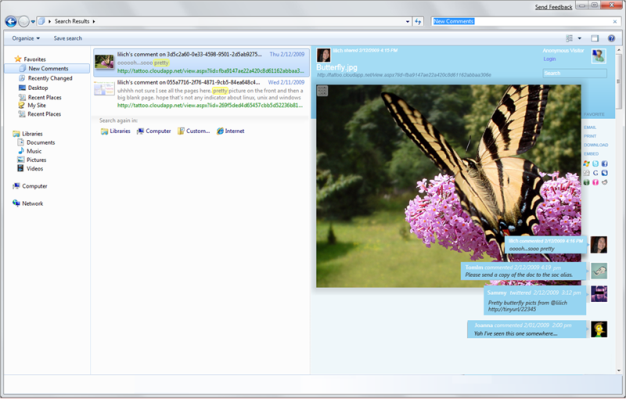 Late last week, Microsoft Research shared a couple of things about Social Desktop, a prototype of which they are debuting at TechFest 2009 in a couple of days (along with dozens of other things). From the looks of it, this will be a much talked about product even if it stays in proof-of-concept phase for now.
Late last week, Microsoft Research shared a couple of things about Social Desktop, a prototype of which they are debuting at TechFest 2009 in a couple of days (along with dozens of other things). From the looks of it, this will be a much talked about product even if it stays in proof-of-concept phase for now.
And if they decide to open it up even just a little, this could be a major breakthrough in tearing down the virtual wall between the desktop and the web, a trend we’ve been noticing for years.
The service would essentially be capable of providing you with a secure unique ID for all the files and folders on your desktop, enabling users to share, comment on, tag and search files like photos and videos via a dedicated web page powered by .NET. Think of this as social URLs that link to files which could easily be pushed to third-party services like Twitter or Digg but also Microsoft’s own Windows Live Messenger without the need for you to copy, move or upload anything. Furthermore, social interaction around the files would be visible from inside the Windows desktop OS, blurring the line between the desktop and the web even more.
You can have a URL drill into a subportion of a document or a PowerPoint deck, or data can come from a Web service or a database. Social Desktop is a local service that maps the user’s local data into a .NET service bus service, enabling local data to be accessible through firewalls. Social Desktop also provides a Web-service view over the same data, with inherent RSS event streams for any container. New data sources can be mapped into the URL hierarchy, enabling a distributed view to be built. There are simple sharing paradigms that enable URLs to be shared temporarily or permanently.
Social Desktop runs on Silverlight and leverages both the Windows OS and Windows Azure, the software giant’s very own cloud services platform which Microsoft announced in October 2008. TechFlash reviewed the service as well last week, and asked the project leads how Social Desktop differs from Live Mesh. The response came from Lili Cheng, who manages Microsoft Research’s Creative Systems Group: “In the Mesh model, you can almost imagine your PC being pushed to the cloud,” she explained. “In this, you can almost imagine the Web being embedded inside your desktop.”

I don’t know about you, but to me this all sounds very promising and I’m curious if using Social Desktop would change my file sharing habits. Even with the plethora of free, simple and fast online backup and sharing services around, there’s still a trust barrier not easily overcome by startups who need to market their services extensively on an inherently low budget to reach any kind of scale. Besides, Social Desktop even relieves you from the not-so-cumbersome task of moving a file to the cloud in order to store or share it, so that makes for one hell of a substantial benefit compared to other services where you’d be required to register and do a series of actions before that happens.
Unfortunately, a Microsoft spokesperson told NetworkWorld that Social Desktop at this point is merely a research prototype which will not be a feature in Windows 7, nor will it be available for public use.
But I still want to get my hands on Windows 7 Beta (it makes use of the new operating system’s file-preview functions) right now even if just to test this application once (and if) they release it.